While perennials add longevity to our gardens, annuals are great for adding a single-season punch of vivid color, interesting form, or a splash of fragrance wherever they’re needed.
They’re terrific in beds and borders, and a mainstay in containers, hanging baskets, and window boxes.
But many of them slow down as summer wears on, fading and wilting, unable to handle the heat and dry conditions, or simply finished with their bloom cycle.

We link to vendors to help you find relevant products. If you buy from one of our links, we may earn a commission.
To ensure that your garden sparkles right until autumn, choose some of the annuals from the following list. There’s a hard-working plant for every environment, from dry or wet conditions to full sun and even deep shade.
Here are 15 of the best performers to add color to your late summer garden:
The Best Annuals for Late Summer Color
Let’s take a closer look!
1. African Marigold (Tagetes erecta)
Also known as American or Aztec marigolds, African marigolds are noted for their large, showy flowerheads in shades of cream, orange, and yellow that grow on tall, sturdy stalks. Both flowers and foliage are fragrant when brushed against or crushed, and plants grow 1 to 4 feet tall, blooming bloom from June to frost.
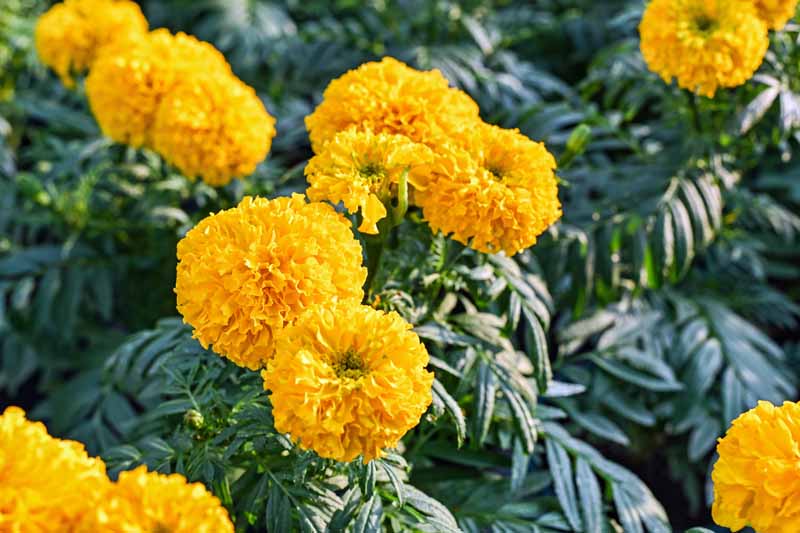
T. erecta is easily grown in well-draining soil of average fertility and even moisture. Plant in full sun and provide some light shade in climates with hot afternoon sun. Remove spent flowers promptly. Provide tall varieties with support by underplanting with smaller French marigolds or plant in a site sheltered from heavy rain and strong winds.
Attractive to butterflies, the bright colors of African marigolds are attractive in beds, borders, containers, and edgings, or as a companion plant to hedge around vegetable gardens.
Burpee has a large selection of marigold seeds to choose from.
Learn all about growing African marigolds right here.
2. Ageratum (Ageratum houstonianum)
Ageratum, or flossflower, gives old-fashioned appeal with its rounded clusters of fluffy, aster-like flowers in shades of blue, mauve, pink, and white. With a mounding habit, it grows 6 inches to 2.5 feet tall, and blooms from May until frost.
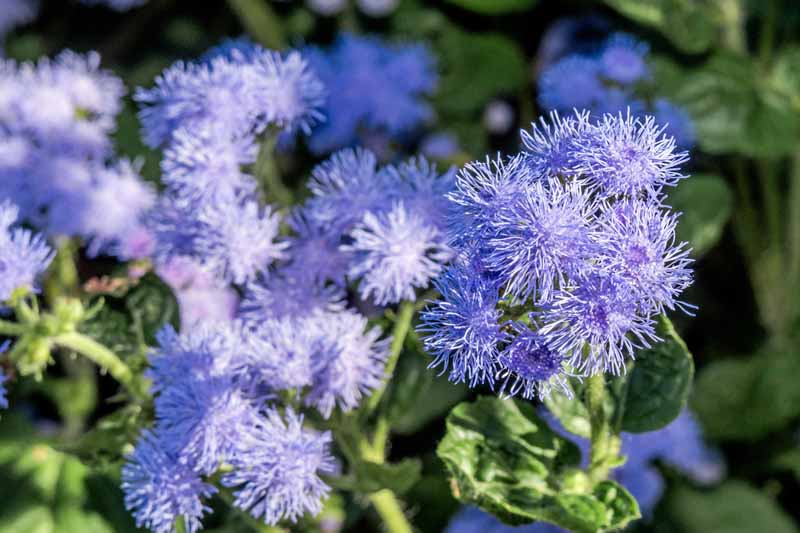
Easily grown in a full sun location with well-draining, humus-rich soil and medium moisture levels. Consistent watering is important as plants can wilt if soils get too dry. Tolerates light shade and appreciates some relief from very hot afternoon sun.
Ageratum attracts butterflies, is rabbit and deer resistant, and the tall varieties make good cut flowers. An excellent bedding plant, it’s well-suited to border fronts, containers, edging, rockeries, and windowboxes.
Find seeds in various shades of blue, white, and red at Eden Brothers.
3. Clary Sage (Salvia viridis/Salvia horminum)
Salvias add reliable late season color, and annual or blue clary sage is grown for its gorgeous bracts of pink, royal blue, or white – the flowers are small and insignificant. Borne on upright stems growing 18 inches to 2 feet high, it’s in high color from June to September.
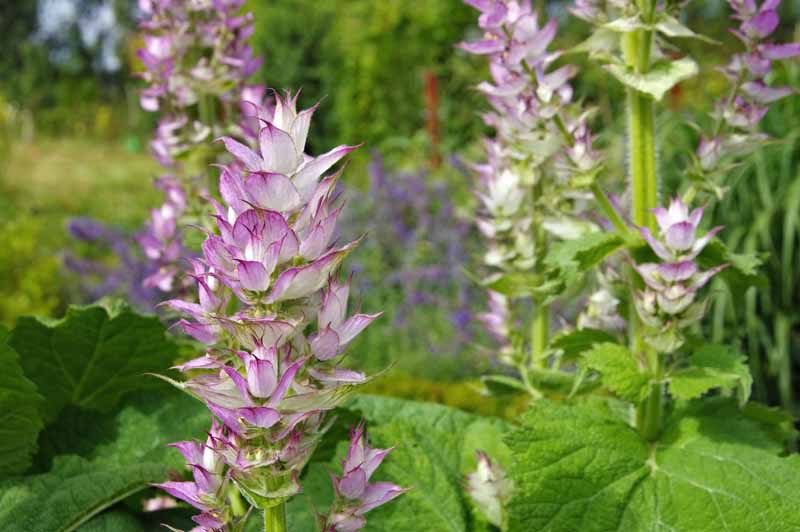
S. viridis grows best in well-draining, humus-rich soil in a full sun location. It benefits from removing spent bracts to prolong flowering and will self-seed readily if a few spent bracts are left in place.
Attractive to butterflies and hummingbirds, it makes an excellent fresh cut or dried flower and is deer and rabbit resistant. Superb when planted en masse or for vertical interest in beds, borders, containers, and cutting gardens.
Eden Brothers has a good range of color choices available.
4. Cleome (Cleome hassleriana)
Cleome, aka spider flower, has loose, airy flower balls in shades of pink, purple, and white with delightfully long, protruding stamens. Borne on upright stems, the fragrant blooms flower from June to frost, growing 3 to 6 feet tall.
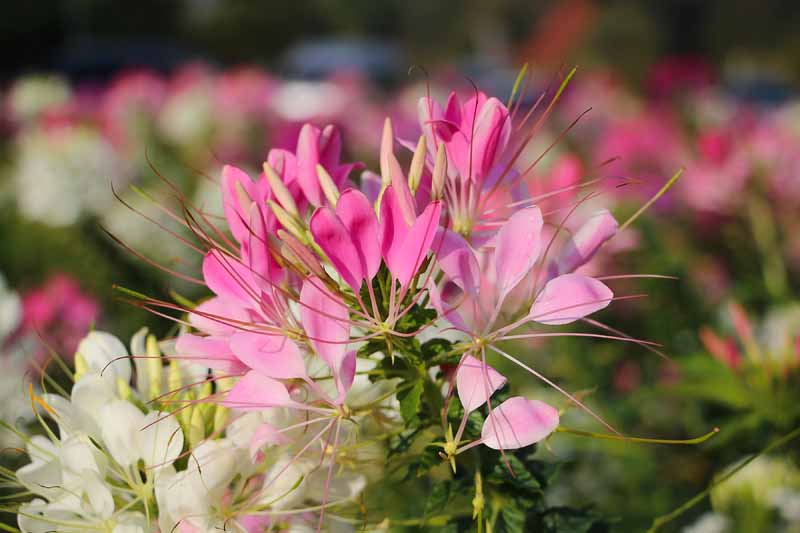
It prefers well-draining soil of average fertility, dry to medium moisture, and full sun. Remove ripe seedheads if you don’t want it to self-seed.
Rabbit resistant and drought tolerant once established, it attracts butterflies and hummingbirds, and birds will visit ripe seedheads in late summer and autumn. Use cleome in the background of beds and borders, butterfly and cottage gardens, containers, or massed in clusters for bold color.
Order seed packets of cleome Queen Mixed Colors from True Leaf Market or read more about growing cleome here.
5. Coleus (Plectranthus scutellarioides/formerly Coleus blumei)
Coleus are tender tropical plants grown for their splendid, multi-colored foliage. Growing 1 to 3 feet high, they display vivid tones of bronze, chartreuse, copper, cream, green, maroon, orange, peach, pink, red, and off-white in endless patterned variations.
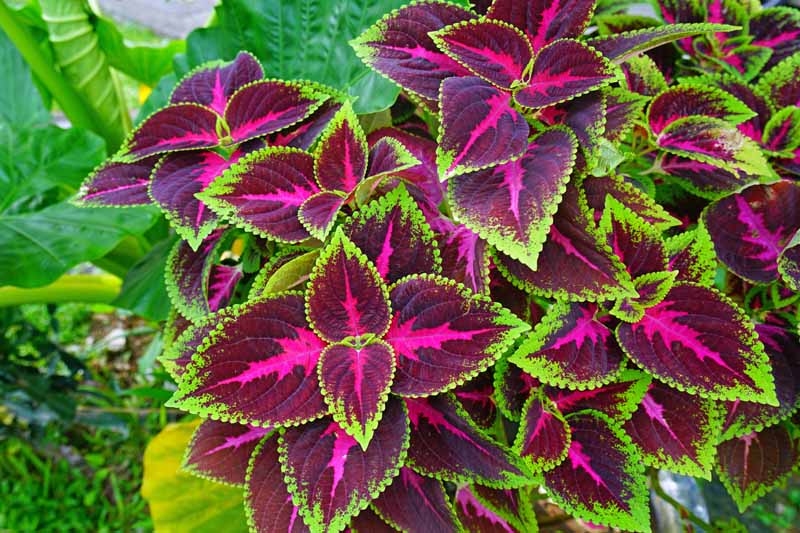
They prefer bright but indirect light and do well in partial to almost full shade. Give them well-draining soil of average fertility and keep the soil moist but not wet – dry soil causes them to wilt. Pinch out flower stems for bushy growth and to direct energy to the foliage.
Coleus is used effectively in the front of beds and borders, containers, hanging baskets, and window boxes in shady areas.
Burpee has several species and colors of coleus to choose from, available in both seeds and plants.
Read more about growing coleus here.
6. Cosmos (Cosmos bipinnatus)
Cosmos produces showy flowers of orange, pink, red, white, or yellow with broad ray florets and yellow center discs that bloom from June to frost, and cultivars can include double rows of petals. It has an upright habit, growing 1 to 4 feet high with erect, multi-branched stems and delicate lacy leaves.

Cosmos does best in well-draining soil of average fertility with moderate, even moisture, and full sun. Deadhead spent flower blossoms but leave some in place for visiting birds, seed collection, or self-seeding.
Attractive to bees, birds, and butterflies, cosmos adds swaying charm to beds and borders as well as cottage, cutting, and naturalized gardens.
Eden Brothers has a good variety of cosmos seeds available in a variety of colors and sizes.
Read more about growing cosmos here.
7. Impatiens (Impatiens walleriana)
One of the most popular bedding plants worldwide, impatiens is another tender perennial grown as an annual, and has a spreading, mounded growth of 6 inches to 2 feet tall. Five-petaled flowers come in shades of mauve, orange, pink, purple, rose, and white, blooming with riotous color from June to frost.
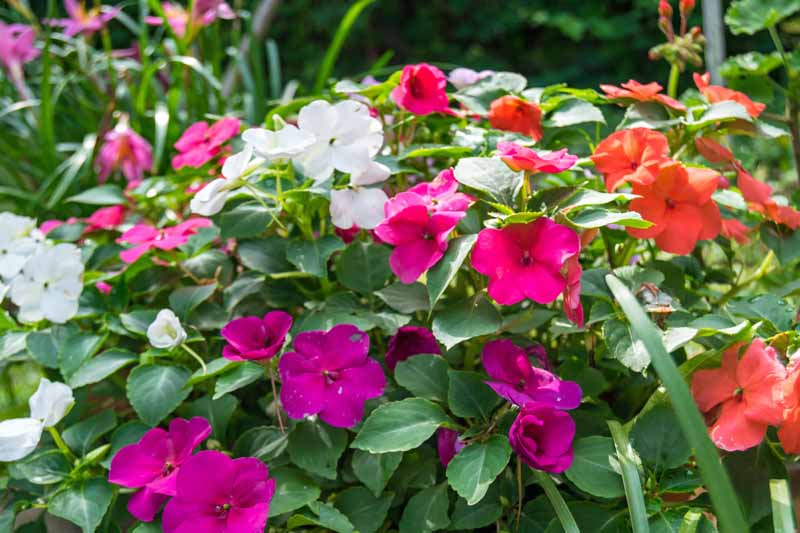
I. walleriana is easily grown in well-draining, humus-rich soil amended with organic matter, with even moisture in a part to full shade site. It even tolerates heavy shade, adding color where most plants fail.
Impatiens look spectacular when massed in shady beds and borders or used as an edging plant along paths and walkways, and grown in containers, hanging baskets, and window boxes.
There’s a large selection of impatiens seeds and plants in mouth-watering colors available for purchase from Burpee.
Find more tips on growing impatiens here.
8. Jasmine Tobacco (Nicotiana alata)
Yet another tender perennial that’s often grown as an annual, jasmine tobacco is nocturnally fragrant and grows 3 to 5 feet high. Tubular flowers in shades of lime green, mauve, pink, red, and white are borne atop upright stems, and bloom from June to frost.
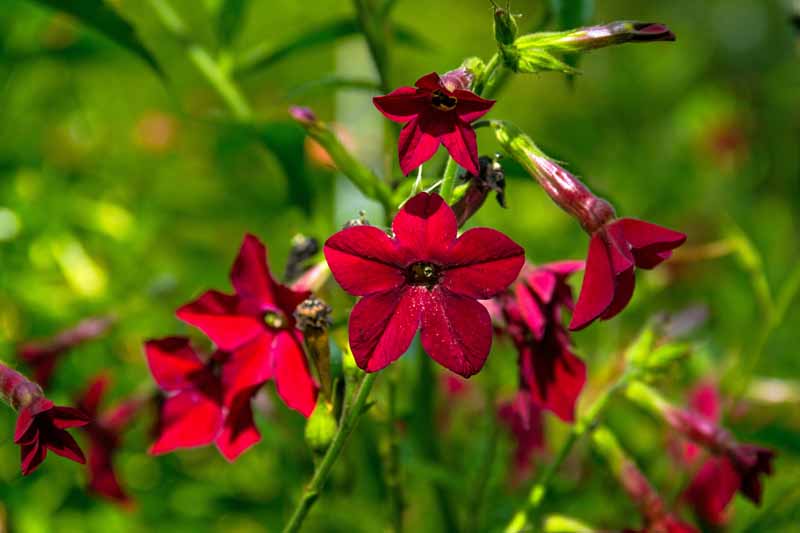
It prefers consistently moist, well-draining, and organically rich soil in a full sun to part shade location. It also appreciates afternoon shade to provide relief from hot sunshine.
Attractive to birds and butterflies, jasmine tobacco looks fantastic planted en masse or in beds, borders, containers, and naturalized settings. Locate fragrant varieties near decks, patios, and open windows.
True Leaf Market has ‘Starmaker’ nicotiana seeds available in various colors as well as a deep purple cultivar. Burpee sells a pink, rose, white and red mix.
9. Mealycup Sage (Salvia farinacea)
Mealycup sage is a clump-forming, tender perennial that’s often grown as an annual. It features large racemes of flowers in shades of blue, purple, lavender, and white, and grows 18 inches to 3 feet high. Flowers grow atop erect, branching stems with shiny, green lancet leaves, and they bloom from May to frost.
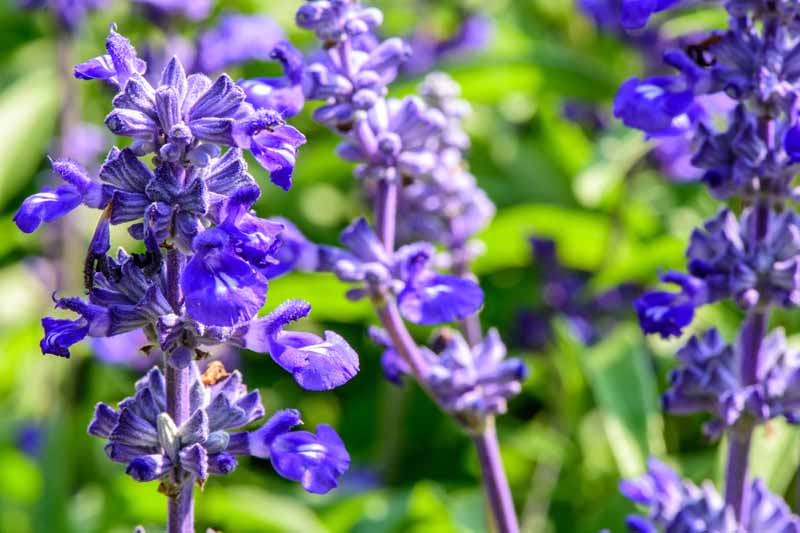
It requires well-draining soil of average fertility, even moisture, and a full sun to part shade location. Tolerant of poor soils and brief – but not extended – droughts. If starting from seed, start indoors 10 to 12 weeks before the last frost date to ensure a good display of flowers. Cuttings can be taken late in the season to overwinter indoors in a cool, bright location.
Attractive to butterflies and deer resistant, mealycup sage adds reliable color to beds, borders, cottage and cutting gardens, and naturalized meadows.
Seeds are available from Eden Brothers.
10. Million Bells (Calibrachoa)
Million bells is a tender perennial grown as an annual, with continuous masses of small, petunia-like flowers in shades of blue, bronze, maroon, mauve, pink, red, white, and yellow. It blooms from June to frost and has a compact, mounding growth of 3 to 9 inches high with a trailing habit.
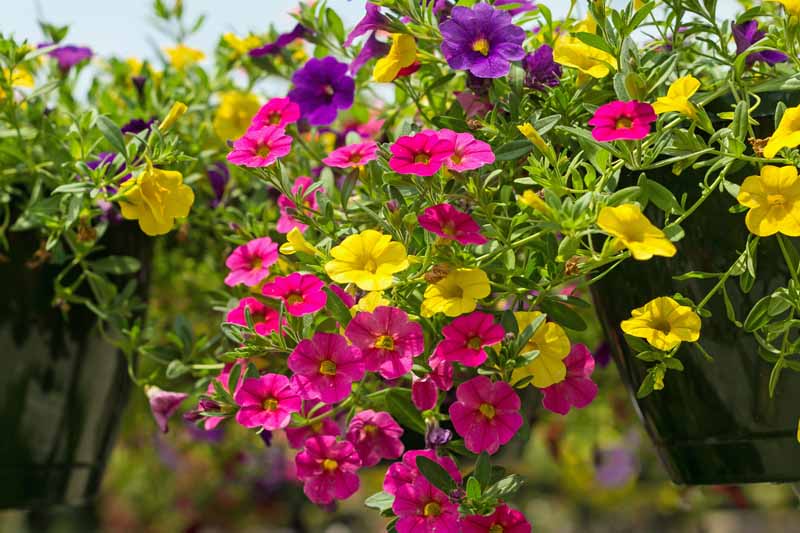
It grows best in well-draining, organically enriched soil with even moisture, in a full sun location. It will tolerate very light shade, but the number of flowers decreases as the amount of shade increases.
Million bells are heat resistant and deadheading is not required. Use them in the front of beds and borders, containers, hanging baskets, rockeries, and windowboxes.
Burpee has Calibrachoa seeds and plants available in a variety of colors.
Find tips on growing million bells here.
11. Moss Rose (Portulaca grandiflora)
Moss rose is a low-growing annual succulent with clusters of ruffled, crepe paper flowers that bloom in clusters from June to frost in brilliant shades of orange, pink, red, rose, white, and yellow. Plants typically grow 6 to 8 inches tall with fleshy, needle-like leaves and flowers in single, semi-double, and double forms that close at night and on cloudy days.
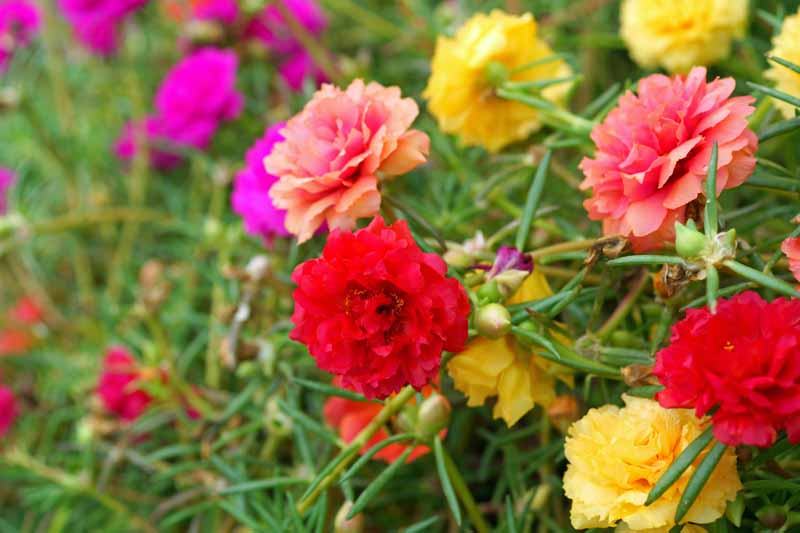
Moss rose is easy to grow in well-draining, average soil with dry to medium moisture and a full sun location. Drought tolerant when established, this is a good choice for poor or dry soils.
Moss rose is attractive to butterflies and works well as an edging plant or ground cover, and in beds, borders, containers, hanging baskets, and rock gardens.
Burpee has two varieties of moss rose seeds available for purchase.
Or find tips on caring for moss rose here.
12. Plains Coreopsis (Coreopsis tinctoria)
Plains coreopsis, or calliopsis, features daisy-like flowers with brilliant yellow petals, a maroon base, and a maroon disc center – and bred cultivars also include flowers in mauve, maroon, pink, red, and purple. They grow 2 to 4 feet tall on stiff, branching stems and flower from June to September.
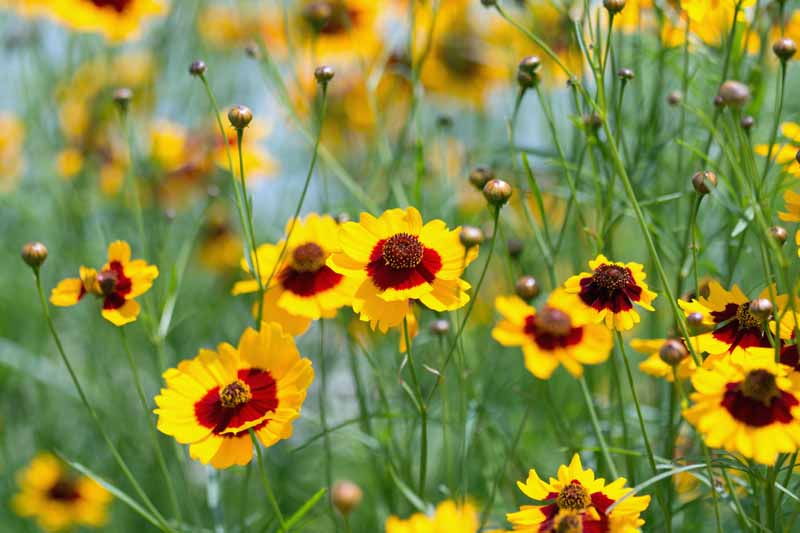
C. tinctoria prefers well-draining soil of average fertility, dry to medium moisture, and a full to part sun location. It’s tolerant of drought conditions and dry, poor, rocky, or sandy soil and will self-seed readily.
Attractive to bees and butterflies, plains coreopsis shines in large plantings and is effective in meadows, naturalized areas, or wildflower gardens. It’s a good choice for sites with poor or dry soil.
Eden Brothers has seed in both the common yellow and red plains coreopsis (as shown above) and as well as a solid deep red cultivar.
13. Petunia (Petunia x hybrida)
Another prevalent bedding plant, the petunia’s popularity is largely due to its bushy, spreading habit with large, trumpet-shaped flowers available in every color except black and brown, including bicolors. The hybrids typically found in garden shops generally grow 10 to 14 inches tall and can spread as much as 2 to 3 feet wide, flowering from May until frost.
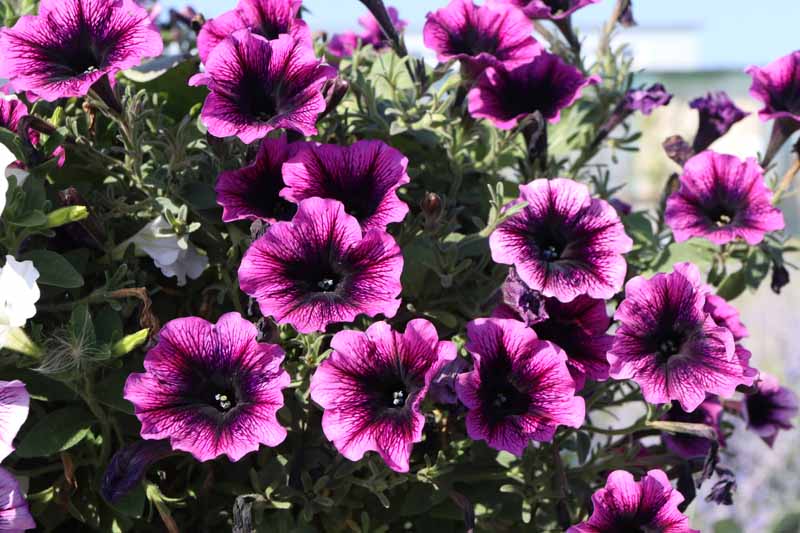
Most have some fragrance, but old-fashioned heirloom varieties, and some specially bred hybrids, are the ones to fill the evening garden with spicy perfume.
Petunias enjoy well-draining soil of average fertility, medium moisture, and a full sun to light shade location. Plants will tolerate poor soil provided drainage is good. Prompt removal of spent flowers encourages faster bud setting, and plants respond well to a light pruning if they become leggy.
Petunias look sensational when mass planted in beds, borders, containers, edging, hanging baskets, and windowboxes.
Burpee has a large variety of petunia seeds and plants available, including the heavenly-scented AAS winner, ‘Evening Scentsation.’
Find out more about growing petunias in this informative article.
14. Rocktrumpet (Mandevilla)
A fast-growing vine, rocktrumpet grows 3 to 10 feet tall, or 3 to 6 feet tall in containers. It features striking, trumpet-shaped flowers in shades of pink, red, white, and yellow set in glossy, dark green leaves, and blooms from June until frost.

A frost-tender tropical perennial, rocktrumpet is usually grown as an annual, but can be overwintered indoors if grown in containers. It prefers well-draining, sandy soil enriched with organic matter and medium moisture, and the soil should be allowed to dry between watering. Plant it in partial shade, with relief from hot afternoon sun, and provide a trellis.
Mandevilla is attractive to hummingbirds and makes an impressive climber – it’s well-suited to add vertical appeal to arbors, large containers, patios, or pergolas.
15. Woolflowers (Celosia)
Woolflowers have showy blooms in bright colors of cream, orange, red, purple, and yellow that bloom from June to frost. Growing 6 inches to 3 feet tall, this old-fashioned favorite has spectacular flowers in a variety of plumed, pyramidal, and coral shapes made of small, densely packed flowers.
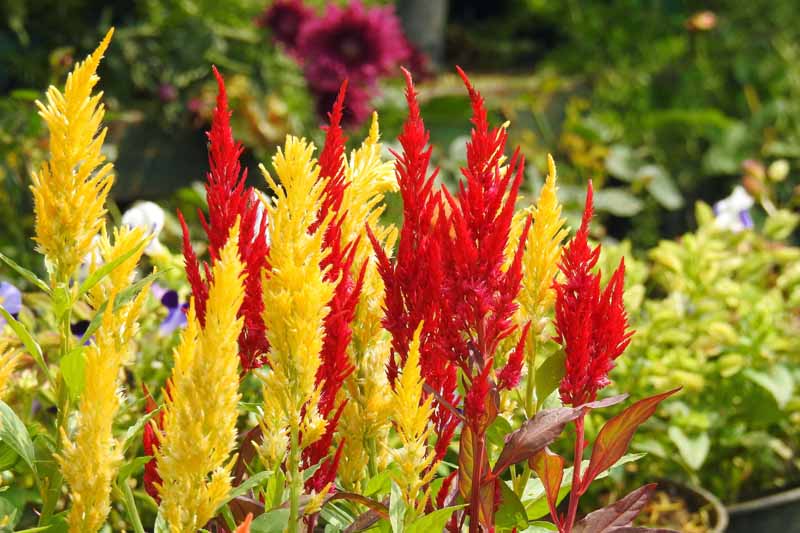
Celosia thrives in heat and humidity and grows well in well-draining soil of moderate fertility with consistent moisture in a full sun site. Protect taller stems from strong winds and deadhead to prolong bloom time.
Bee and butterfly friendly, woolflowers are good as fresh cut or dried flowers. Most effective when mass planted, add them to beds, borders, containers, and edgings.
True Leaf Market has several species of celosia to choose from.
The Late Summer Solution
Annuals are perfect as bedding plants, giving aromatic color and form to any planting area, and they’re the ideal solution to filling in tired or lifeless spots in the late summer garden.
Whether you need them for full sun locations, shady spots, dry areas, or wet soils, there’s an annual on our list to meet your needs for late summer color.
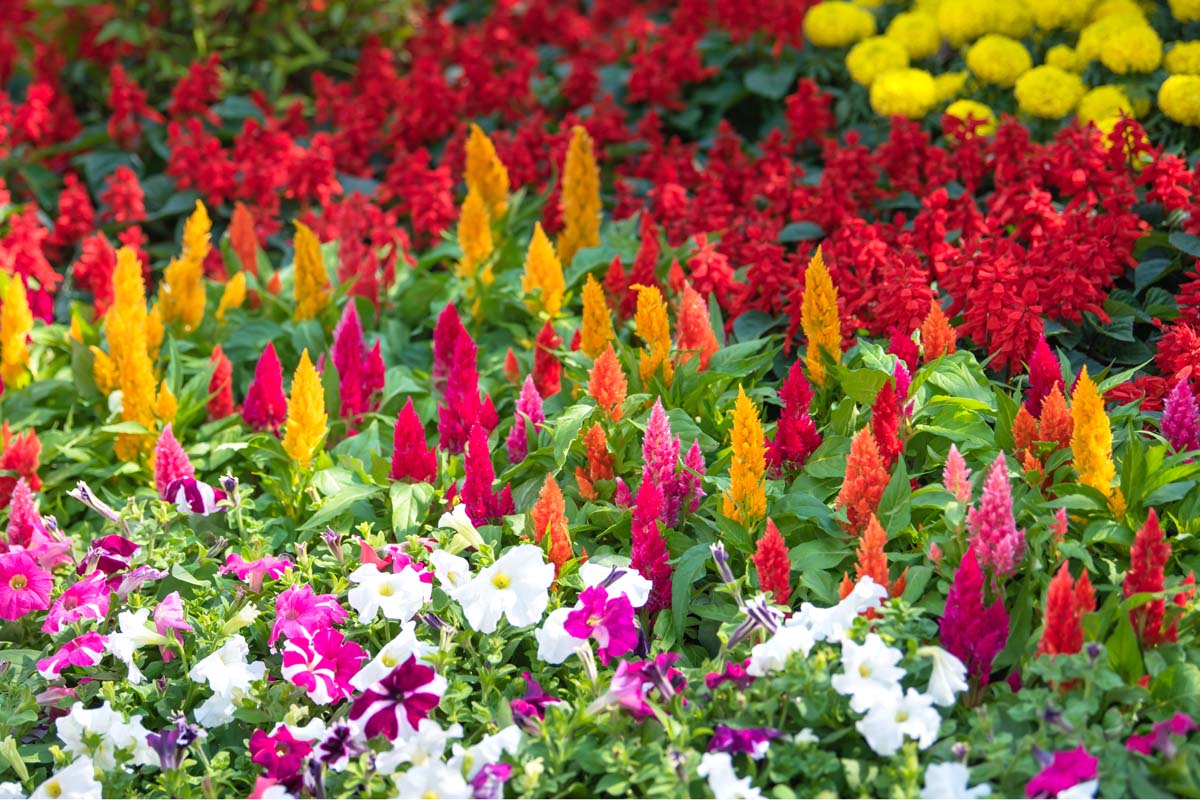
Do you have any questions about these plants, or suggestions we might have missed? Drop us a note in the comments below.
And be sure to check out some of our other late summer and fall planting guides to get the most out of the season! These will be of interest:

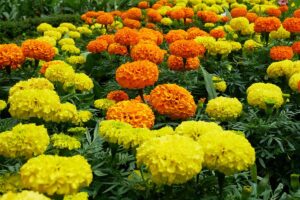

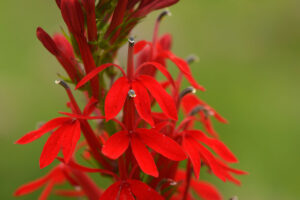
What happens to the Mandevilla vine at the end of the year? Do you end up with a bunch of leafless stems on your trellis? Do they ever re-seed themselves or would I have to buy a new plant each year?
Hey Drew, mandevilla is a tender perennial hardy only in USDA Zones 10-11, and plants die off with hard frost.
They might self seed, but seedlings won’t survive cold winters.
Outside of their hardiness zone, they can be overwintered indoors. Bring containers in once temperatures start to drop below 50 degrees F and place in a bright location with indirect light. Water when the top one inch of soil is dry.
Place outdoors again when temperatures stay above 50 degrees F.
Thanks for your question!
Can I sow Nicotiana Alata seeds in the fall or winter for early flowering in spring?
Hey ulas ocal, N. alata are half-hardy perennials commonly grown as annuals and the seeds need warm temperatures to germinate, in the range of 65 to 75°.
If you live within their hardiness range of Zones 10 to 11, you might have some luck with a fall planting, but they won’t germinate any earlier – they still need those warm temps.
A more reliable method for early flowers would be to start your seeds indoors six to eight weeks before your last frost date, or your usual planting date.
Thanks for asking!